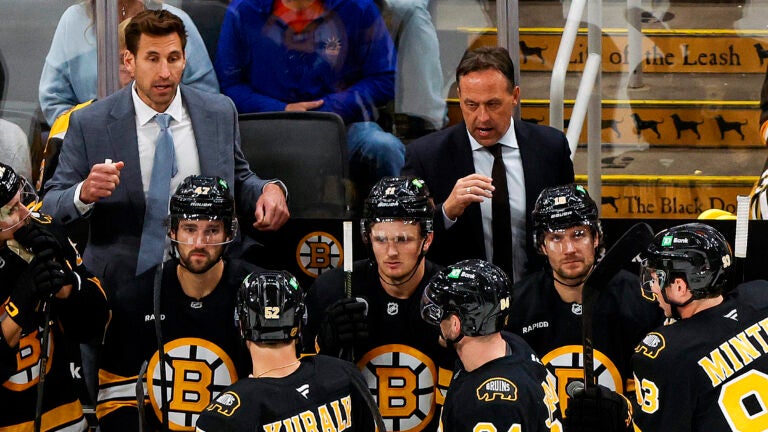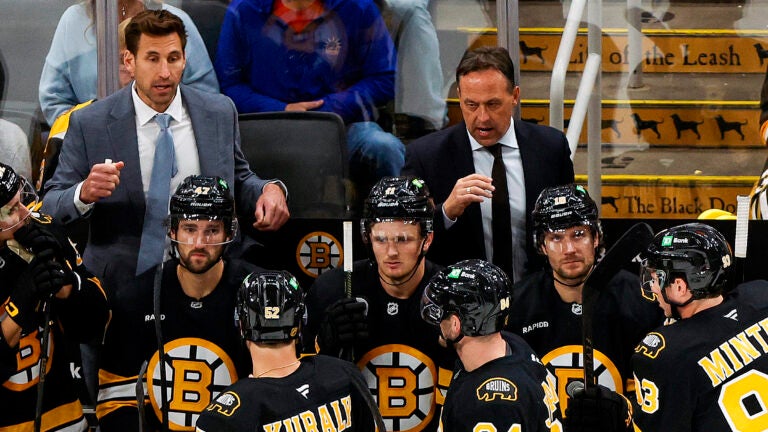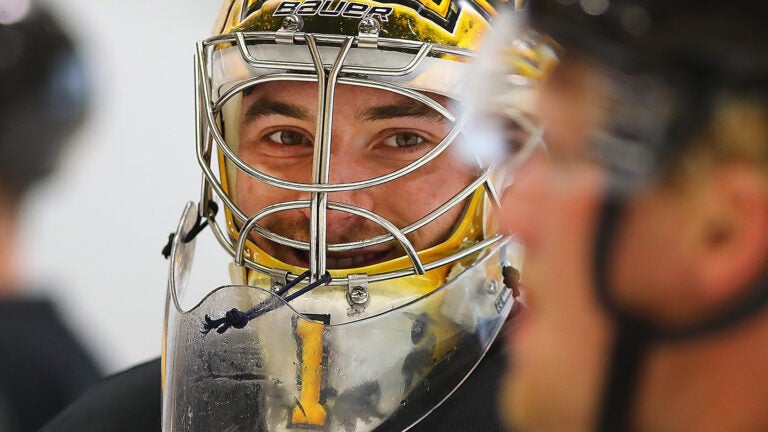Boston Bruins
The Bruins still have several question marks regarding their forward corps.

Hockey is finally back in Boston.
As first-year head coach Marco Sturm takes the reins of the Bruins, a retooling Boston roster still has plenty of question marks in place.
Here are eight questions that will determine whether or not an intriguing — albeit flawed — Bruins roster can exceed expectations this winter.
Can Jeremy Swayman bounce back?
Nothing will hold as much weight over the Bruins and their fortunes this season than whether or not Jeremy Swayman can regain his form as one of the top young goalies in the league.
If the Bruins are going to be a competitive squad under Sturm, they’re going to need to be a gritty, grind-it-out club that pummels opponents on the forecheck, capitalizes on special teams — and relies on their goaltending to keep them afloat in what should be plenty of one-goal games.
It’s a clear template, but one that only becomes feasible for the Bruins if Swayman bounces back between the pipes.
A tumultuous training camp (or lack thereof) for Swayman loomed large over a lost season for the 26-year-old, who went from a .933 goalie in the 2024 Stanley Cup Playoffs to a career-worst .892 save percentage in 2024-25.
There is still plenty of pressure on Swayman’s shoulders as Boston’s No. 1 netminder.
But, Swayman seems to be in a better place with a clean slate presented by this season — as evidenced by his strong showing during World Championships (7-0, .921 save percentage) and a .942 save percentage across two preseason games.
If Swayman can right the ship, the Bruins could be a hard out, even with their evident weaknesses up front.
Can Marco Sturm leave his stamp on this team?
Sturm hasn’t changed his messaging since the start of the summer when it comes to deficiencies on this team.
Beyond David Pastrnak’s offensive wizardry, consistent 5-on-5 scoring will likely be hard to come by this winter.
As such, the Bruins will have to augment their approach on the ice, placing a premium on a punishing forecheck and a suffocating defensive structure in order to steadily accrue points.
It may not be the most riveting product at times. But, it’s the proper formula to maximize the potential of a retooling roster that’s far from a finished product.
It can be perilous to make any sweep conclusions from preseason action, but both of Boston’s “dress rehearsal” games on Sept. 29 and Oct. 4 featured the Bruins adhering to a structured defensive system, with big bodies like Tanner Jeannot pinning puck carries, Boston’s skaters trapping players in the neutral zone, and D-men like Hampus Lindholm ferrying pucks out of danger.
Sturm’s vision will likely be a work in progress, especially on the offensive side when it comes to spurring an effective power play and finding another avenues of offensive production.
But, some of the non-negotiables that Sturm has preached — effort, physicality, and a bruising forechecking approach — can conceivably keep Boston competitive on most nights.
“I want to see growth, right? I want to see us come together,” Sturm said Tuesday of his expectations for this season. “I’m not going to say we’ve got to make the playoffs, or we got to be in a playoff spot in November with this and that.
“No. I want to see us grow. I want my players to play the way we all want them to play and get that identity back, not just one day, not just one period. Very, very consistent.”
Can Boston’s top line continue to thrive?
There shouldn’t be any concerns about Pastrnak, who scored 43 goals and 106 points on a cellar-dwelling team last season.
But, given all of the uncertainty further down the depth chart, the Bruins are going to need to rely heavily on the rest of Boston’s top line to pull on the rope this season.
There was a lot to like about how a top forward trio of Pastrnak, Morgan Geekie, and Elias Lindholm ended the year, considering they outscored opponents, 16-2, at 5-on-5 play after Boston’s trade-deadline teardown.
Boston will need some of that production to carry over into next season.
Geekie could be due for some regression after scoring 33 goals last season, but an uptick in power-play production could help him after generating most of his offense at 5-on-5 play (26 goals, tied for second in NHL) last year.
Lindholm is also a player who looked far more comfortable down the stretch, posting 15 points over his final 17 games.
Can McAvoy, Lindholm elevate a porous defense?
The loss of Hampus Lindholm and Charlie McAvoy for a majority of last year stood as the final nail in the coffin amid a rudderless season. Without their two most impactful, minutes-munching blue-liners, Boston’s usually rigid D-zone structure wilted. The team ranked 26th in the NHL in goals allowed per game (3.30).
The absence of Lindholm and McAvoy created a devastating domino effect for the Bruins, putting younger skaters like Mason Lohrei into elevated roles and making life harder on an already laboring Swayman.
Beyond banking on a bounce-back in net from their top goalie, the Bruins are feeling confident that the club will regain its hallmark defensive fortitude so long as McAvoy and Lindholm are healthy and hoping over the boards, night in and night out.
Coming off of a fractured kneecap that cost him 65 games last year, Lindholm looked no worse for wear during preseason play — carrying pucks through the neutral zone, logging taxing D-zone shifts, and activating off the blue line in the offensive zone.
Can the Bruins reignite their power play?
A familiar talking point for Sturm and the Bruins so far this preseason has been the emphasis on elevating a Bruins power play that wielded the firepower of a spud-gun for most of 2024-25.
Given all of the uncertainty regarding Boston’s middle-six grouping, a lot is going to be asked of Boston’s top line and power-play personnel to keep the club’s offensive production afloat — especially in the early going.
Boston’s man advantage was downright dysfunctional at times last year, with far too many stretches of play marred by disjointed zone entries, one-and-done attempts, and an unpredictable script that often ended with PKers bottling up Pastrnak’s one-timer.
After ranking 29th in the NHL in power-play success rate (15.2 percent) last year, the Bruins are making a concerted effort to right the ship on special teams. The organization brought in assistant coach Steve Spott to overhaul that power-play unit.
Be it shifting Pastrnak into more of a “rover” role on the power play, augmenting their personnel, or shifting their approach through the neutral zone, the Bruins need to find ways to generate an uptick in production in that area of the game.
Where will the secondary scoring come from?
The Bruins feel good about their personnel both on the first line and top power-play unit.
The same can’t be said for Boston’s middle-six grouping, which features several players who are either coming off of underwhelming offensive seasons or are unproven in the NHL ranks.
Entering Wednesday’s season opener, the Bruins will roll out a second line of Pavel Zacha, Casey Mittelstadt, and Viktor Arvidsson. Zacha — who has averaged 54.3 points per season over his three years in Boston — should be a steady, two-way presence on that line.
But, the Bruins are placing a lot of trust in Mittelstadt realizing his potential as a true top-six playmaker, while a former 30-goal-scorer in Arvidsson had a season to forget (15 goals, 27 points) on an Oilers squad where simply skating in the presence of Connor McDavid usually sets your scoring floor at 50 points.
Boston’s third line of Fraser Minten, Tanner Jeannot, and Mikey Eyssimont should be a straight-line, bruising group out on the ice this season. But they’re not exactly an offensive juggernaut, with that trio scoring just 19 combined goals last season.
Expect plenty of growing pains this season as the Bruins try to find proven conduits of offense outside of their big guns atop the depth chart.
Can younger players develop?
One of the top priorities for the Bruins this season is cultivating the growth of Boston’s next wave of talent — be in the NHL ranks or further down the pipeline.
Minten was a standout during camp, with the 21-year-old earning a spot as Boston’s third-line center during preseason action. But, can any players down in Providence join him this season?
A strong showing from Matt Poitras in Providence would accelerate his path back to Boston, while other players in the AHL like Frederic Brunet and Dans Locmelis could also earn looks in the NHL.
He’s not a prospect anymore, but Lohrei is also a younger player with plenty of prove after going through some defensive-zone growing pains under heavy minutes last season. If he can remedy some of the warts in his game, the 6-foot-4 blueliner could be a weapon on Boston’s blue line.
Of course, most of the optimism rooted in Boston’s prospect pool is rooted in the college game, where fans will be keeping close tabs on BC sophomore James Hagens and an Eagles club featuring several Bruins prospects. If Hagens thrives in his second year at Chestnut Hill, he could earn a cup of coffee with the Bruins by the spring.
Will a captain emerge?
Don Sweeney, Sturm, and Boston’s veterans have all brushed aside concerns over the team’s vacancy at captain entering a new season — opting for a leader to emerge via an “organic” process as the year carries on.
Pastrnak and McAvoy are the leaders in the clubhouse when it comes to the likelihood of eventually getting a “C” stamped on their sweater, but how that process plays out and how that duo navigates what could be a tumultuous season will be worth monitoring.
Beyond dealing away their former captain in Brad Marchand, the Bruins lost several pillars of their former leadership hierarchy at the trade deadline in Brandon Carlo and Charlie Coyle.
The onus will be on returning veterans like Hampus Lindholm, Elias Lindholm, and Nikita Zadorov — coupled with offseason pickups like Jeannot and Sean Kuraly — to fortify Boston’s leadership group beyond Pastrnak and McAvoy.
Sign up for the Today newsletter
Get everything you need to know to start your day, delivered right to your inbox every morning.





